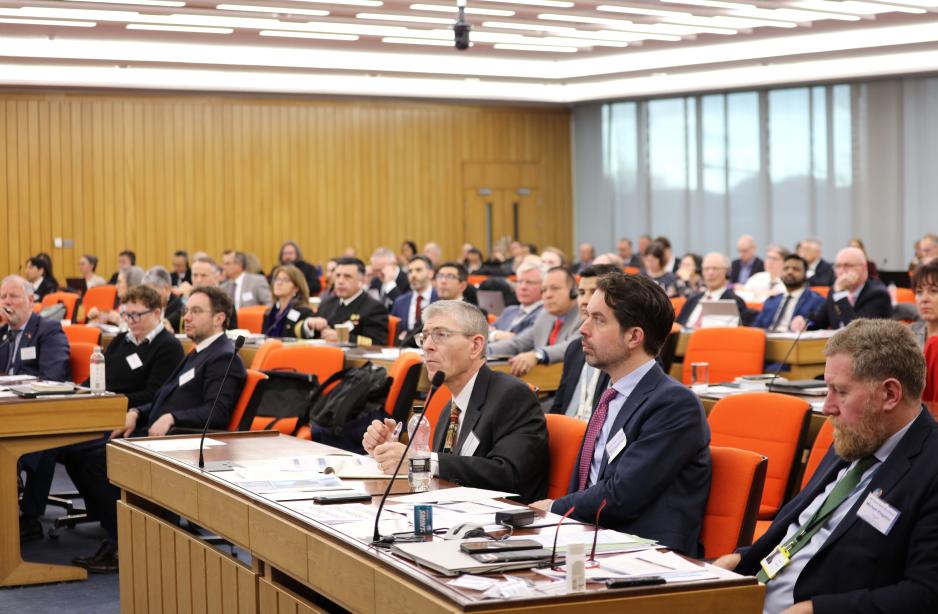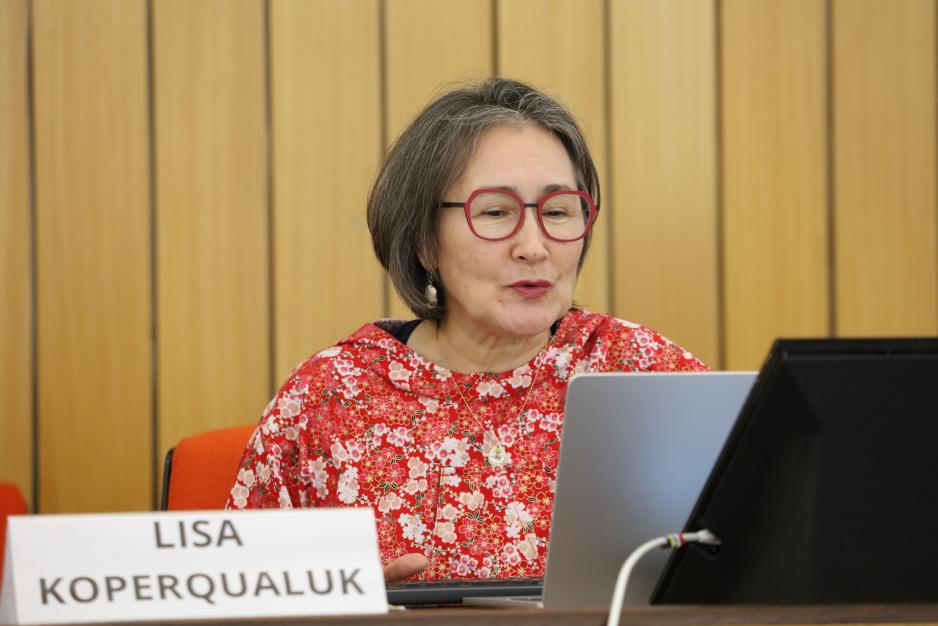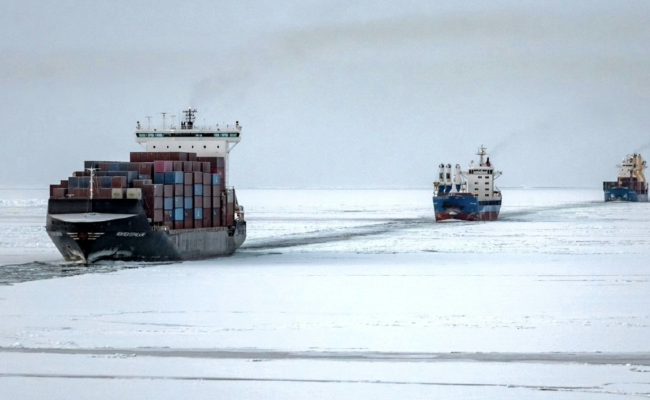Navigating the Future of Polar Shipping: Key Insights from the IMO-Norway Maritime Seminar

IMO and Norway's Chairship of the Arctic Council, in cooperation with the Protection of the Arctic Marine Environment Working Group of the Arctic Council (PAME), are organizing a Polar Maritime Seminar, co-sponsored by Norway as Chair of the Arctic Council, in cooperation with PAME (23-24/01/2025). The photo is from the fourth session called on search and rescue. (Photo: International Maritime Organization via Flickr)
In January, leading experts, researchers, policymakers, and industry leaders gathered in London for the International Maritime Organization (IMO) and Norway’s Arctic Council Chairship Polar Maritime Seminar. Researchers Alina Kovalenko and Michaela Coote have compiled some key takeaways from the session.
This is an opinion piece written by external contributors. All views expressed are the authors' own.
On January 23-24, leading experts, researchers, policymakers, and industry leaders gathered in London for the International Maritime Organization (IMO) and Norway’s Arctic Council Chairship Polar Maritime Seminar.
The event, organized in collaboration with the Arctic Council’s Protection of the Arctic Marine Environment (PAME) Working Group, addressed critical regulatory developments, operational challenges, and environmental concerns in polar shipping. Discussions focused on the ongoing POLARIS review, the Cape Town Agreement, Arctic emission regulations, Indigenous engagement, and the evolving risks of ice navigation.
Evolving Trends in Polar Shipping: Arctic and Antarctic Perspectives
The Arctic shipping industry is undergoing significant shifts as climate change accelerates ice loss, with the region warming four times faster than the global average. While this warming is enabling increased shipping activity, it is not the primary driver. The Northern Sea Route (NSR) remains the most accessible, but the Transpolar Route may become a more viable option than the Northwest Passage, depending on future ice conditions.
Unprecedented seasonal anomalies are becoming more frequent, with 2024 marking the first year with no major ice choke points in the Northwest Passage.
Although vessel traffic and distances traveled in Arctic waters are rising, advanced risk assessments like POLARIS navigational models indicate a decline in high-risk operations.
However, Russia and Eastern Greenland remain high-risk areas, largely due to ice conditions and regulatory inconsistencies. Given that, experts stress the need for integrating multiple data sources to improve tracking accuracy and better assess safety risks.
By contrast, Antarctic shipping remains highly regulated under the Antarctic Treaty System, which enforces strong environmental protections. The long-standing heavy fuel oil (HFO) ban was implemented well before similar Arctic measures.
A key distinction between the two regions is that Antarctica lacks a coastal state, making treaty regulations functionally equivalent to national laws. Despite the rapid decline in Antarctic sea ice, shipping accessibility and patterns have not significantly changed.
The Antarctic fleet primarily consists of fishing vessels, cruise ships, and government icebreakers, with about 75 fishing vessels operating in 2023. However, illegal and unreported fishing remains a concern.
The cruise industry is expanding, shifting towards smaller expedition vessels over large cruise liners. Both polar regions face data inconsistencies, underscoring the need for enhanced tracking systems and regulatory oversight to support safe and sustainable operations in rapidly changing conditions.
POLARIS System Under Review: Enhancing Arctic Shipping Safety
The Protection of the Arctic Marine Environment (PAME) Working Group has launched a review of POLARIS, the system used to assess the operational capabilities and limitations of ships in polar waters.
Originally developed as interim guidance and approved by the Maritime Safety Committee in 2016, the system was meant to be reviewed within four years based on experience gained. However, delays, including those caused by COVID-19, have postponed the review.
The Arctic Council, with Canada co-leading the initiative, is overseeing the POLARIS Review Project to determine whether updates are necessary. A correspondence group of approximately 50 experts, including representatives from Arctic states, industry stakeholders, and NGOs, has been convened. The first expert meeting took place recently to initiate discussions on the review.
One key concern raised in the discussions is the challenge of interpreting and applying POLARIS assessments correctly, as a high level of ice concentration knowledge is required. While the system is a valuable tool for ship operators navigating ice-covered waters, experts note that a high level of knowledge about ice conditions and vessel limitations is required to correctly interpret and apply POLARIS assessments.
This makes it particularly challenging for less experienced operators. There is also limited structured feedback on operational experiences, making it difficult to incorporate lessons learned into the system for improvement.
Suggestions for refinement include reviewing ice classification methods, reassessing risk levels, and incorporating real-world feedback from experienced ice navigators. Additionally, discussions have touched on the potential for including operational limitations on ship certificates to help administrators and operators better assess vessel capabilities.
The review will continue with further data collection and input from naval architects, engineers, ice specialists, and regulatory bodies. The objective is not to overhaul POLARIS but to refine it into a more precise and user-friendly, and data-driven system that reflects evolving Arctic conditions.
Fishing vessels remain exempt from mandatory regulations under the Polar Code.
The Cape Town Agreement and Fishing Vessel Safety: Bridging Regulatory Gaps
Despite being the largest category of vessels operating in polar waters, fishing vessels remain exempt from mandatory regulations under the Polar Code—a major concern raised during the recent seminar.
Experts emphasized the high-risk nature of fishing operations, as the sector records one of the highest occupational mortality rates in maritime industries.
The Cape Town Agreement (CTA), established in 2012 to enhance fishing vessel safety, has been signed by 23 states. Its origins trace back to the 1977 Torremolinos International Convention, which never entered into force, followed by unsuccessful amendments in 1993. The 2012 agreement has struggled to reach the required ratification threshold, with only 3,600 of the necessary 14,000 fishing vessels currently included.
To advance CTA ratification, Iceland and Spain, in collaboration with the IMO, are leading an Arctic Council project titled "Raising Awareness of the 2012 Cape Town Agreement."
The initiative provides technical support for implementation through online training and informal workshops for interested stakeholders. Findings from the project underscore the need for greater engagement from countries with fishing fleets exceeding 600 vessels, urging them to join the agreement to enhance safety standards in polar waters.

Lisa Qiluqqi Koperqualuk of the Inuit Circumpolar Council (ICC) highlighted that tackling underwater noise is a key priority for the ICC. (Photo: International Maritime Organization via Flickr)
Addressing Underwater Noise: IMO Regulation and Indigenous Perspectives
The seminar highlighted the IMO’s efforts to enhance Arctic shipping regulations, focusing on noise reduction, emissions control, and fuel safety.
Experts outlined that revised guidelines take a comprehensive approach to addressing underwater radiated noise, focusing on both the physical sources of noise and the operational management of vessels.
Key measures include hull and machinery modifications, wake flow improvements, and propulsion system optimization. Strategies such as engine isolation, vibration control, and propeller cavitation reduction, supported by advanced systems technology, aim to achieve significant noise reduction in sensitive ecosystems.
Changes to maritime activities impact local Arctic communities' way of life in both positive and negative ways. Lisa Qiluqqi Koperqualuk of the Inuit Circumpolar Council (ICC) highlighted that tackling underwater noise is a key priority for the ICC.
The ICC developed the “Circumpolar Inuit Protocols for Equitable and Ethical Engagement” in 2022, which should be considered when addressing this issue. Ms. Koperqualuk emphasized that the IMO has a fundamental obligation to engage with Indigenous Peoples on this issue. While current IMO regulations on underwater noise remain voluntary, an “Arctic Annex” would help address noise challenges in an Arctic-specific context.
Changes to maritime activities impact local Arctic communities' way of life in both positive and negative ways.
Green Transition: Arctic Emission Control and Fuel Adaptation Challenges
In the Polar Seminar, the discussion focused on Canada’s recently adopted Arctic Emission Control Area (ECA) and its environmental and health benefits. Initially excluded from the North American ECA due to limited data and lower shipping activity, the Canadian Arctic has since experienced increased maritime traffic due to melting ice, necessitating stricter emission controls.
The new ECA aims to reduce sulfur oxides by 80%, particulate matter by 74%, and black carbon by 59%, mitigating climate change effects and improving air quality, especially for indigenous communities reliant on marine ecosystems.
Approved in 2024, the regulations will come into force on March 1, 2026, with full implementation by March 1, 2027. Additionally, Canada has introduced strategies, such as the Northern Policy Framework, to curb black carbon emissions, ensuring a healthier and more resilient Arctic environment. Discussions are underway to extend ECAs to cover more Arctic waters.
Another key debate at the seminar was the impact of MARPOL Annex VI regulations and the Arctic HFO ban on July 1, 2024. While the shift to Ultra-Low Sulfur Fuel Oils (ULSFOs) aims to reduce emissions, experts highlighted unique risks, including fuel instability, handling challenges in Arctic conditions, and reduced oil spill recovery efficiency.
Key technical concerns include viscosity, pour point, and density, which affect fuel behavior in cold environments. High pour points necessitate onboard heating, increasing operational complexity. Additionally, fuel composition changes have hindered oil spill response efforts, as skimmers struggle with new formulations.
Balancing environmental goals with operational feasibility remains a key challenge in Arctic shipping.
Experts emphasized the need for practical solutions alongside high-tech innovations, particularly in vessel salvage operations. Recommendations included monitoring pour points, mandating fuel property reporting in bunker delivery notes, and adopting best practices to minimize black carbon emissions and spill risks.
Balancing environmental goals with operational feasibility remains a key challenge in Arctic shipping.
Additionally, experts and participants discussed the new EU fuel regulations that will require ships operating between Europe and the Arctic to transition to alternative fuels.
The key question was whether the existing icebreakers and ice-class vessels should switch to untested fuels or continue using ULSFO and face penalties. One recommendation was to explore fuel blending, particularly integrating biofuels with existing fuel types. Although biofuels are known to be less toxic, their behaviour when mixed with conventional fuels like SFO remains uncertain under Arctic conditions, highlighting a critical knowledge gap.



